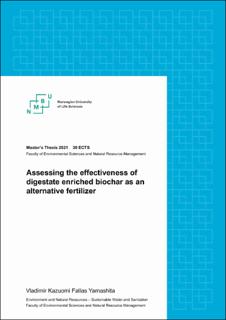| dc.contributor.advisor | Martinsen, Vegard | |
| dc.contributor.advisor | Stoknes, Ketil | |
| dc.contributor.author | Fallas Yamashita, Vladimir Kazuomi | |
| dc.date.accessioned | 2021-11-30T08:54:32Z | |
| dc.date.available | 2021-11-30T08:54:32Z | |
| dc.date.issued | 2021 | |
| dc.identifier.uri | https://hdl.handle.net/11250/2832018 | |
| dc.description.abstract | Background: Alternatives to conventional inorganic fertilizers are needed if we are to curve CO2 emissions, reduce the stress on natural resources and develop an efficient, yet sustainable agricultural practice. Biochar and digestate are two promising materials whose combined properties can be harnessed for plant nutrition. Although literature exists on the use of biochar and digestate aimed at nutrient recovery and agriculture, relatively little is known on the effectiveness of enriched biochar compared to conventional fertilization.
Aim: This thesis purports to compare the effects of digestate enriched biochar on plant productivity and nutrient availability with respect to conventional inorganic fertilizers.
Method: A pot trial with ryegrass was conducted with five different treatments over a period of six weeks to study the effects of digestate enriched biochar on plant productivity, nutrient availability, and nitrogen mineralization. Shoot biomass yield, macronutrient concentration in biomass and mineral nitrogen (N) concentrations in soil were measured. In addition, a 24-hour sorption batch test was conducted to study the ammonium and orthophosphate sorption capacity of biochar.
Results: The enriched biochar treatment displayed the best performance in shoot biomass yield, 54.7% higher than conventional fertilization. Biochar was also found to have an effect on increased yields across several treatments containing the same source of N. This observation can potentially be explained by the interaction between microbial activity and biochar. The study could not verify N mineralization, but nitrification (a part of N mineralization processes) was observed in all treatments, with the highest final concentration of nitrate in the enriched biochar treatment. Biochar was also found to adsorb ammonium (NH4+) effectively with an estimated capacity of 5.45 mg NH4+ g-1. Inversely, a release of orthophosphate (H2PO4-) by more than 4 mg H2PO4- g-1 was observed.
Conclusion: This study indicates that enriched biochar is a promising alternative to inorganic fertilizers in terms of shoot biomass yield and N availability. However, more studies are needed to understand its long-term fertilization effects. Desorption of orthophosphate from biochar should also be examined more in detail. Finally, studies on the synergies between microbial activity and biochar are needed to understand/explain the higher productivity levels displayed by the biochar treatment. | en_US |
| dc.description.sponsorship | Lindum AS | en_US |
| dc.language.iso | eng | en_US |
| dc.publisher | Norwegian University of Life Sciences, Ås | en_US |
| dc.rights | Attribution-NonCommercial-NoDerivatives 4.0 Internasjonal | * |
| dc.rights.uri | http://creativecommons.org/licenses/by-nc-nd/4.0/deed.no | * |
| dc.subject | biochar | en_US |
| dc.subject | digestate | en_US |
| dc.subject | alternative fertilizer | en_US |
| dc.subject | nutrient recovery | en_US |
| dc.subject | sorption batch test | en_US |
| dc.subject | ammonium | en_US |
| dc.subject | orthophosphate | en_US |
| dc.title | Assessing the effectiveness of digestate enriched biochar as an alternative fertilizer | en_US |
| dc.type | Master thesis | en_US |
| dc.subject.nsi | VDP::Agriculture and fishery disciplines: 900::Agriculture disciplines: 910::Agricultural technology: 916 | en_US |
| dc.subject.nsi | VDP::Technology: 500::Environmental engineering: 610 | en_US |
| dc.description.localcode | M-MINA | en_US |


